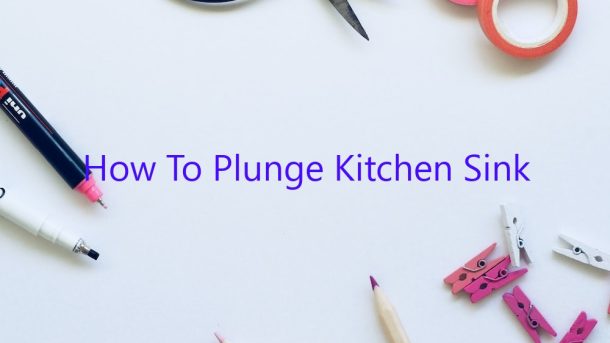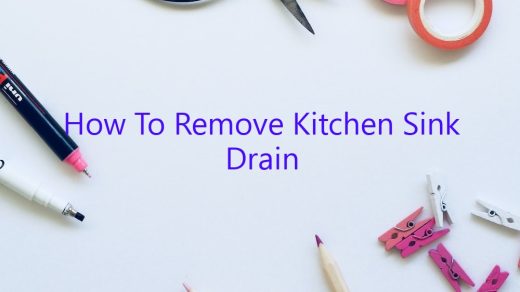It’s happened to all of us at one time or another. You’re in the middle of doing the dishes and all of the sudden the kitchen sink stops working. Water starts backing up and before you know it, you’ve got a big mess on your hands. But don’t worry, fixing a clogged kitchen sink is actually a lot easier than you might think.
The first thing you want to do is try to plunging the sink. This is often the quickest and easiest way to clear a clog. If the water is backed up all the way to the top of the sink, you might have to use a plunger with a longer handle. Make sure you have a good seal around the plunger, and plunge up and down quickly. You should see the water start to drain.
If plunging doesn’t work, you might want to try using a plumbing snake. This is a long, coiled wire that you can feed down the drain. You can buy a plumbing snake at most hardware stores. Turn the snake clockwise as you insert it into the drain. If you feel any resistance, stop and try to wiggle the snake around a bit. This should help break up the clog.
If the clog is really stubborn, you might have to call a plumber. But before you do that, try using a dishwasher detergent tablet. This can help dissolve the clog. Drop the tablet into the drain and let it sit for a few hours. Then try plunging or using a snake.
If all of these methods still don’t work, it might be time to call a plumber. They will have the tools and experience to clear the clog quickly and efficiently.
Contents
Can I use a plunger on my kitchen sink?
Can I use a plunger on my kitchen sink?
Yes, you can use a plunger on your kitchen sink. However, you should be careful not to splash water out of the sink onto yourself or your floor.
What is the best way to unclog a kitchen sink?
There are a few different ways that you can unclog a kitchen sink. The most common way is to use a plunger. You can also use a plumber’s snake or a vinegar and baking soda mixture.
If you are using a plunger, you should pour some water into the sink and then place the plunger over the drain. You should then push and pull the plunger up and down a few times. If the clog is not too big, this should work.
If you are using a plumber’s snake, you should put it into the drain and twist it around a few times. This will hopefully break up the clog.
If you are using a vinegar and baking soda mixture, you should mix together a cup of vinegar and a cup of baking soda. You should then pour this mixture down the drain and let it sit for a few minutes. After a few minutes, you should pour hot water down the drain.
Will plunging a sink unclog it?
Plunging a sink is a common way to unclog it. When water accumulates in the sink and doesn’t drain properly, it can be frustrating. The good news is that plunging the sink may be all you need to clear the clog and get your sink draining properly again.
To plunge a sink, you’ll need a plunger. You can either use a cup-style plunger or a flange plunger. If the clog is in the sink’s P-trap, the cup-style plunger will be more effective. If the clog is further down the drain, the flange plunger will work better.
Once you have the plunger, fill the sink with enough water to cover the plunger’s head. Then, place the plunger over the drain and push and pull the plunger up and down. Be sure to use enough force to create a good seal over the drain. You should also try to create a rhythm with your plunging.
If the clog is in the sink’s P-trap, the water in the sink will start to drain. Keep plunging until the water drains completely. If the clog is further down the drain, the water may not start draining right away. Be patient and keep plunging. You should start to see results after a few minutes.
If plunging the sink doesn’t work, there are a few other things you can try. You can try using a plumbing snake to clear the clog or pour a pot of boiling water down the drain. If none of these methods work, you may need to call a plumber.
Can you plunge a sink without a plunger?
When your sink becomes clogged and refuses to drain, the usual solution is to use a plunger. However, what if you don’t have a plunger? Can you still plunge the sink?
The answer is yes, you can still plunge the sink without a plunger. All you need is a bucket or container to create a suction seal over the drain and some water. Pour the water into the bucket or container and then place it over the drain. Cover the top of the bucket or container with your hand and then plunge the sink. The suction from the bucket or container will create a seal and force the water and clog out of the drain.
Which plunger is best for kitchen sink?
Which plunger is best for kitchen sink?
There are many different types of plungers on the market, but not all of them are suitable for use in the kitchen. In general, you want to use a plunger that is large and has a rubber cup on the end. This type of plunger is best for clearing clogs in the kitchen sink.
If you are having trouble removing a clog from your sink, try using a plunger. First, make sure that the plunger is the right size for your sink. The plunger should be large enough to cover the entire opening of the sink. Next, fill the sink with water until it is about two inches deep. Be sure to avoid filling the sink with too much water, as this can make the plunger ineffective.
Then, place the plunger over the sink and push it down into the water. Be sure to make a tight seal between the plunger and the sink. Pump the plunger up and down a few times to create a suction seal.
Once you have created a seal, start pumping the plunger up and down quickly. You should see the water start to move. If the clog is not cleared after a few minutes, stop and try again later.
If the clog is cleared, run some hot water down the drain to clear out any remaining debris.
If you are having trouble removing a clog from your sink, try using a plunger. First, make sure that the plunger is the right size for your sink. The plunger should be large enough to cover the entire opening of the sink. Next, fill the sink with water until it is about two inches deep. Be sure to avoid filling the sink with too much water, as this can make the plunger ineffective.
Then, place the plunger over the sink and push it down into the water. Be sure to make a tight seal between the plunger and the sink. Pump the plunger up and down a few times to create a suction seal.
Once you have created a seal, start pumping the plunger up and down quickly. You should see the water start to move. If the clog is not cleared after a few minutes, stop and try again later.
If the clog is cleared, run some hot water down the drain to clear out any remaining debris.
How do you unclog a sink with standing water?
When your sink becomes clogged with standing water, it can be a frustrating and messy experience. But before you call a professional, there are a few things you can try to unclog it on your own.
The first step is to try using a plunger. Put the plunger over the drain and make sure it’s completely covered. Then, push and pull the plunger up and down a few times. If the clog is strong, you may need to do this for a few minutes.
If the plunger doesn’t work, you can try using a wire hanger. Bend the hanger into a U-shape and insert it into the drain. Then, use the hanger to try to dislodge the clog.
If neither of these methods work, you can try pouring a pot of boiling water down the drain. This will usually dissolve the clog.
If none of these methods work, it’s time to call a professional. They will be able to use a snake or a hydrojet to clear the clog.
Can plunging make a clog worse?
When a clog forms in a drain, one of the first steps people often take is to try to plunge the clog out. However, some people may wonder if plunging can actually make a clog worse.
Plunging is a technique that uses air pressure to push water and clogs through a pipe. The plunger creates a seal around the drain, and then air is forced through the plunger and into the clog. This air pressure can help to break up the clog and push it through the pipe.
However, if the clog is very large or if there is a lot of built-up grease or gunk, plunging may not be able to break it up. In these cases, the clog may get worse after plunging. The air pressure may push the clog further down the pipe, and it may be harder to remove.
If plunging doesn’t seem to be working, it may be best to try another method, such as using a snake to clear the clog.




